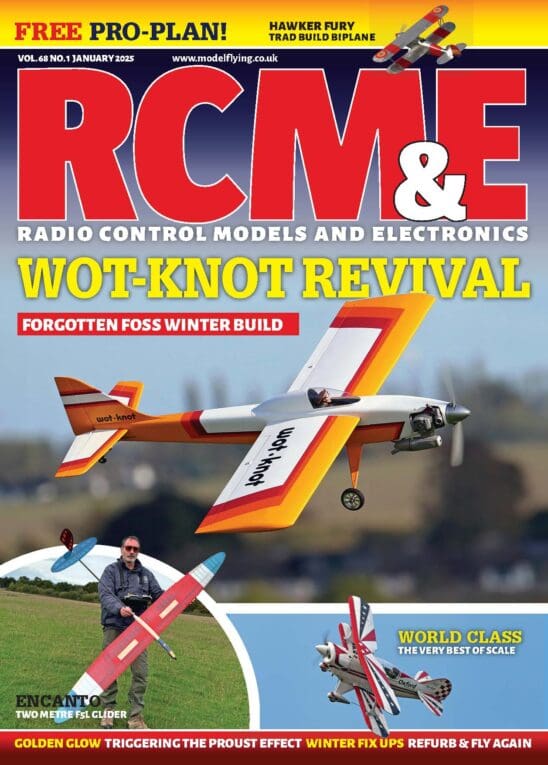Does Arrows’ Edge 540 fly as good as it looks? David Ashby straps in…
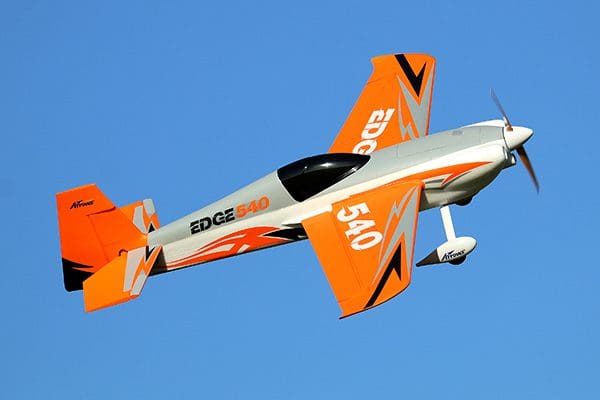
As the most common aircraft you’ll have seen negotiating the pylons in the Red Bull Air Race World Series, Zivko’s Edge 540 will be familiar to most model flyers. It has been the subject of countless R/C versions over the years and vies with the Extra 300 as the ARTF model manufacturer’s default aerobat. Being so ubiquitous lends the machine an air of familiarity, yet a little online research will certainly enhance your appreciation of the type.
It went into production in 1995, quickly garnering a reputation for fast and aggressive yet well-balanced characteristics. It can handle up to 12G, plus and minus, a bit more than the Extra 330SC, and specialises in fast turns and quick climbs. At 420 degrees per second the roll rate isn’t too shabby and, let’s be honest, it looks pretty darn good too.
Enjoy more RCM&E Magazine reading every month.
Click here to subscribe & save.
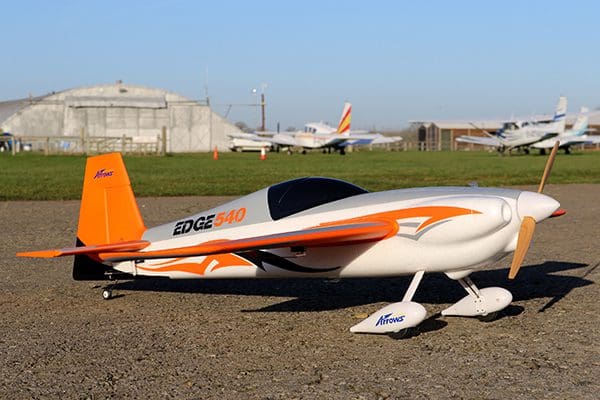
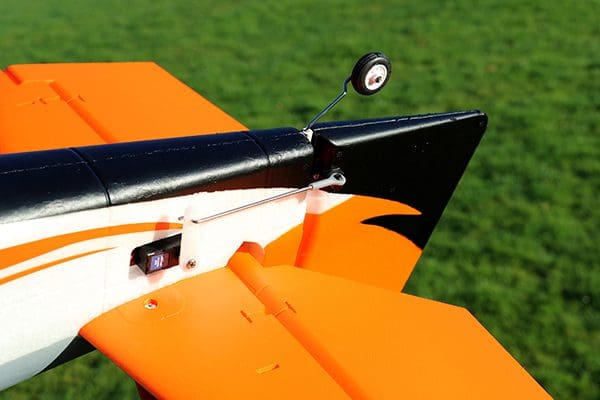
3D EDGE
For subject matter, while Arrows Hobby have followed convention with this new release, I think opinions will converge on the fact that they’ve done a really fine job, especially thanks to a nicely applied finish that’s as good as any EPO foam R/C aerobat I’ve seen. Spanning 1300mm (51”) this ‘540 will fit inside most cars fully rigged, yet it’s not so small that it won’t turn heads at the flying field or fall hostage to the elements on a breezy day.
An onboard stabiliser helps in this respect, with the factory-fitted Vector unit (common to most Arrows releases) offering three flying modes: Stability, Dynamic and Direct. More on these in a moment.
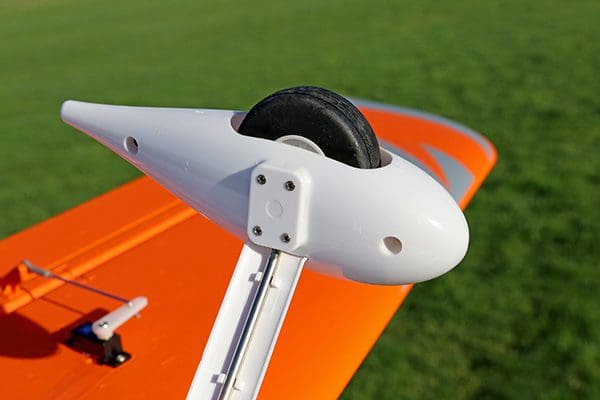
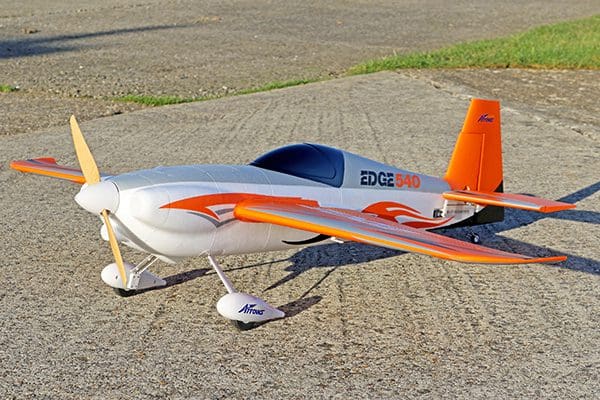
If you’ve owned or flown a foamie ready-to-fly model over the last few years then you’ll quickly realise that while this Arrows release isn’t groundbreaking, what’s here has been done very well. From the smoothly moulded EPO foam airframe sections to the strong plastic spats and control horns, there’s good stuff where there needs to be.
The props and spinners included with such kits can sometimes seem like a bit of an afterthought, especially when you run up the motor for the first time and find yourself treated to a symphony of noise and vibration. Not so here thanks to a nicely balanced 13″ x 6″ wooden prop and spinner.
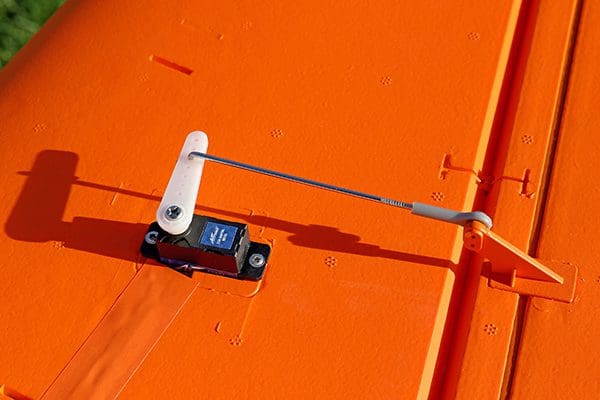
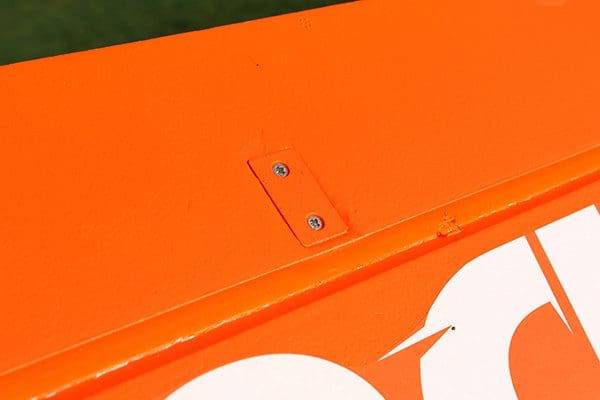
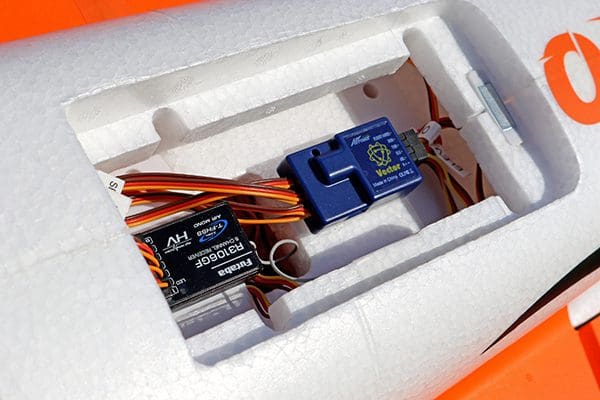
ASSEMBLY
The instruction manual is up to Arrows’ usual high standard, so assembly and set-up should take no more than a leisurely hour or so. I only encountered one niggle; attaching the wing halves requires a fair bit of patient wriggling so that the screws can slip down into place and bite home. It’s why my wings will stay on rather than repeat this frustrating process before every flying session!
The rudder must be attached using cyano hinges whilst slotting home the tailwheel guide wire. A small plastic tab on the fuselage rudder post ensures correct separation during the process.
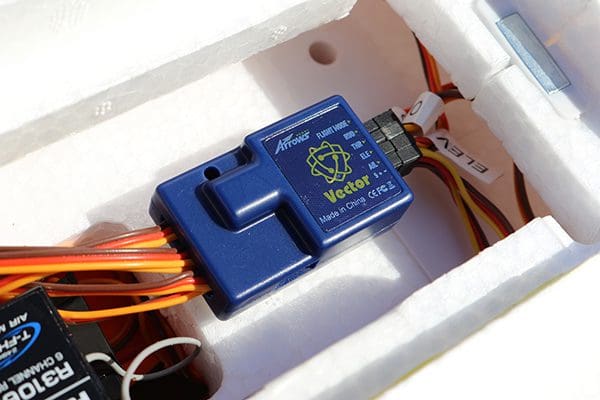
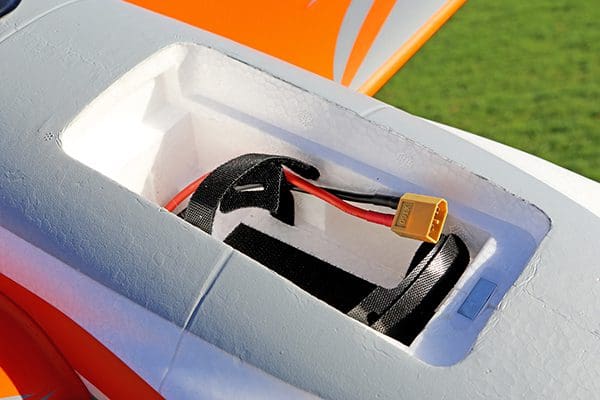
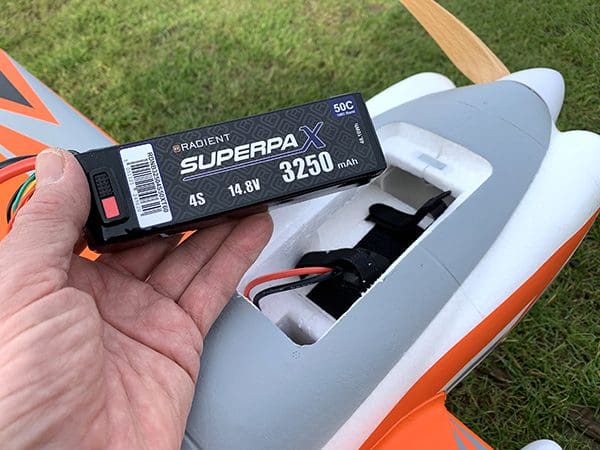
Four 23g digital metal gear servos move the control surfaces via solid ball-link connectors and back-plate secured horns. While the aileron pushrods are connected at the factory, those for the rudder and elevator must be added during assembly and adjusted accordingly. Ball link pliers come in handy at this stage.
The undercarriage assembly is ready to slot home and slips into place, clamped by a screw-down plastic plate.
SET-UP
There are two magnetically retained hatches; one on top, just behind the nose, reveals the battery compartment and another on the underside exposes the Vector gyro and receiver space. Arrows say the gyro has been programmed specifically for this Edge. It’s all wired up and ready to connect to your SBus or PPM receiver.
A separate instruction sheet guides the Vector set up and an LED on the unit indicates the flying mode selected. Once allocated to three-position switch three modes are available:
Stability is the self-levelling mode that returns the model to level flight when no control inputs are selected. Intermediate or experienced pilots can use it to get out of trouble but the manual’s suggestion of ‘perfect for beginners’ should be taken to mean ‘beginners to powerful aerobatic models’, not those new to R/C flying.
Dynamic mode gives the pilot complete control, only making adjustments if movement is detected that’s not initiated by the pilot, such as from gusts and turbulence.
Direct is gyro off and flying without electronic intervention.
It’s useful to note the modes and relative switch position as a handy reminder before flying. Although the channel can be reversed (and the mode order inverted) ordering the modes in order of personal preference isn’t possible.
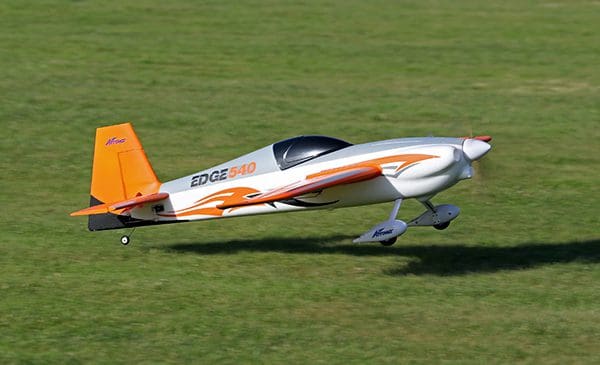
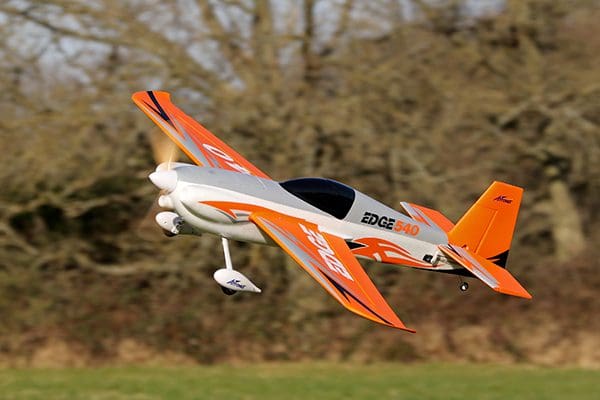
The manufacturer suggests using a 30C 4S 2600mAh LiPo, which is fine if you have some batteries that size. I didn’t so used my 3000mAh and 3250mAh Radient 4S LiPos. They weigh 280g and 350g respectively, so bring the C of G forward, although the model flies well with either pack. The 3250s push duration up to a respectable seven minutes of aerobatic shenanigans. If 3D flying is your thing then you’ll probably opt for the smaller and lighter 4S packs suggested as a way of shifting the C of G aft and reducing all up weight to help during those fully stalled manoeuvres.
PROPER EDGE
Try and think about your own personal aerobatic style before the first flight. What’s it to be? All out 3D? Traditional pattern style manoeuvres? Or a bit of both? I say that because simply dialling in the high rates and sending it skywards isn’t the best way to become acquainted with a powerful and highly agile machine. You could become very uncomfortable very quickly.
Everyone has their own set-up preferences. I prefer a traditional aerobatic flying style, so I started with the low rates suggested in the manual. Even so, the control surface deflections still appeared pretty large, so I added 35% exponential all-round to soften things up. Not long into the first flight I landed to reduce the deflections further.
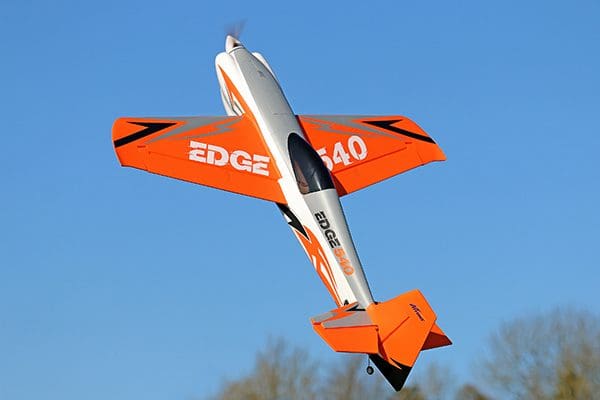
The feel had improved through the second flight but now the model’s slightly stogy response told me there was too much expo. Dialled down to 20% things were getting there and I tweaked away over the next few flights, finding an increase to rudder deflection necessary in order to provoke a decent spin.
Stability mode is quite fun and instantly returns the model to straight and level flight from any attitude, even inverted. It’s certainly a very useful ‘get-out-of-jail’ facility. Other than that, most pilots will feel they’re fighting Stability mode as it levels the wings every time the sticks are centered.
POWER
This is a fast and powerful machine that’s predictable and simply goes where you put it. The words ‘unlimited verticals’ tend to be taken with a pinch of salt but punching away from a high alpha pass or prop hang is something this Edge will certainly do. That wooden prop makes a nice sound too.
The roll rate is fast, even using the lower control surface deflections suggested and, as you’d expect, rolls are noticeably smoother in Dynamic mode.
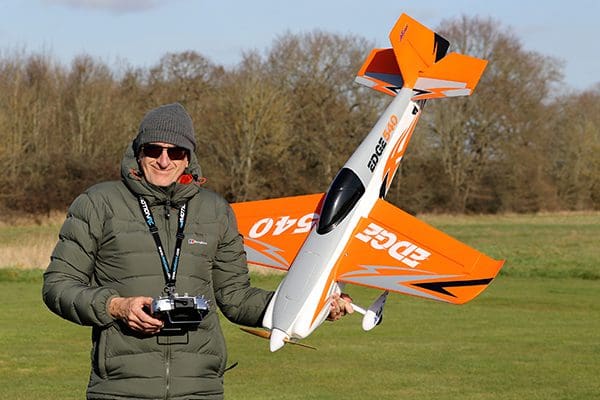
Dynamic mode is what I tend to fly the most. To be honest, it makes me look a better pilot. My knife edge passes are smoother and through which the model doesn’t pull towards the U/C as much as it will in Direct mode. Rolls are more axial and inverted flight is more assured, with just a hint of stick pressure required to hold the nose up. I’ve flown through 12-15mph gusts where, again, Dynamic mode evens out the bumps and blips. The same applies when landing, especially when there’s a cross wind element.
Forcing a stall eventually produces a modest wing drop, but nothing sudden or nasty. Generally speaking, this is a benign and friendly aeroplane. Stability mode helps delay that moment, but the result is the same once the stall proper is entered.
ALL UP
It’s quite common to find on-board gyro stabilisers fitted to RTF models these days and although the Vector unit’s settings can’t be adjusted, the defaults seem about right and can always be switched off if preferred.
Apart from that fiddly wing fit there’s nothing to dislike here. The Edge 450 from Arrows Hobby is a powerful and capable aerobatic machine that, treated with respect, should certainly put a smile on your face.
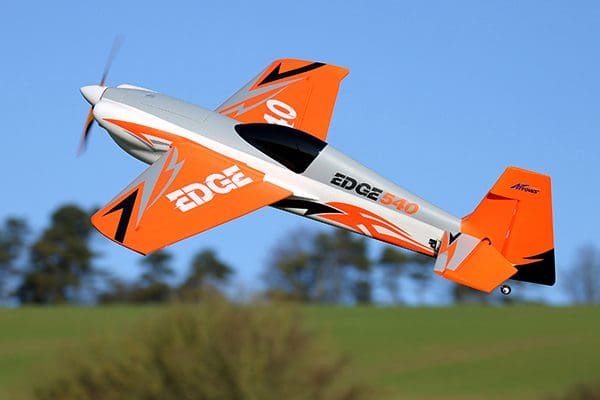
DATAFILE
Name: Zivko Edge 540
Model type: Ready-to-fly aerobat
Manufactured by: Arrows Hobby
UK distributor: J.Perkins Distribution
www.jperkins.com
RRP: £299.99
Wingspan: 1300mm
Fuselage length: 1260mm
Wing area: 503.4 sq.in. (32.5dm2)
All up weight: 1900g
Power system: 4250-size 910kV outrunner, 60A ESC, 13″ x 6″ prop, 4A 2600mAh 30C LiPo
Functions (servos): Ailerons (2), elevator (1), rudder (1), throttle (via ESC), Vector gyro with three modes
Connector type: XT60
Required to fly: Transmitter, receiver, 4S LiPo


